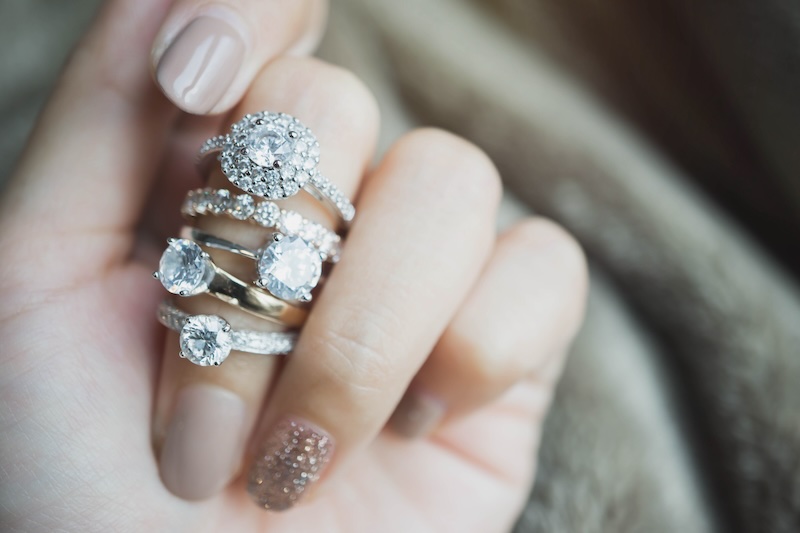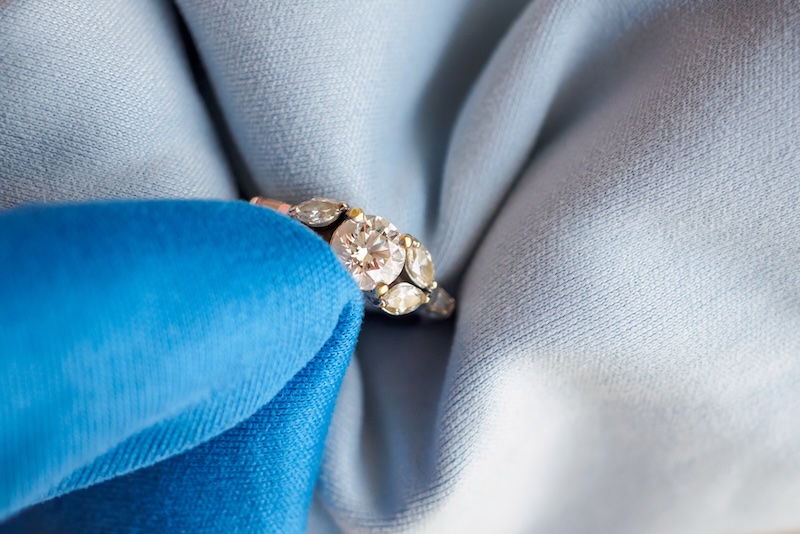How to Clean Your Engagement Ring Like A Pro
Tips and tricks to keep your ring finger sparkling.

Tips and tricks to keep your ring finger sparkling.

Your engagement ring isn’t just a piece of jewelry, it’s a symbol of love and commitment. Keeping it sparkly for a lifetime is the dream, but how do you make sure you’re doing it right?
Let’s brush up on proper engagement ring cleaning etiquette, and take a look at how Lemonade renters insurance can add an extra layer of protection to your precious gems.

Here’s a step-by-step guide, with best practices for cleaning different types of stones and cuts at home.
Keep in mind: If your ring has unique features, antique value, or you’re unsure about the best cleaning method, consulting with a professional jeweler is the safest approach. They can provide tailored advice based on the specific materials and design of your ring.
Here’s what you’ll need:
Using a mild dish soap and warm water mixture is typically a good option if your ring band is made from gold (including yellow, white, and rose gold), titanium, platinum, or tungsten.
But silver tarnishes more easily than other metals, so if your ring band is made from silver, it’s recommended to use a silver polish along with a soft cloth, or a liquid cleaning solution that’s specifically formulated for silver to avoid damage.
For bands made of non-traditional materials—like wood or silicone—follow the manufacturer’s cleaning instructions, as these materials can require specialized care.
If you want a professional-esque cleaning without leaving home, consider buying a specialized cleaner—like the Magnasonic Digital Ultrasonic Jewelry Cleaner.
Mix warm—not hot—water with a few drops of dish soap in a small bowl. The key here is to use enough soap to create a gentle cleaning solution without making it overly sudsy or soapy.
If you see a few bubbles on the surface after stirring or swirling the water, that’s typically a good sign. The solution should not feel overly slippery or soapy to the touch. If it does, you might have added too much soap, and should add a bit more warm water to dilute it.
Place your engagement ring in the solution and let it soak for about 20 to 40 minutes. If you’re using an ultrasonic cleaner, follow the manufacturer’s instructions.
If your ring is particularly dirty, you might see particles or oils coming off into the water. Once you stop seeing significant dirt release, it’s usually a sign that the ring is clean.
Soaking for too long, especially overnight, is generally not recommended. Extended soaking can potentially weaken the metal or the settings, especially in rings with softer stones or intricate designs. For example, prolonged exposure to water can sometimes loosen glue used in certain settings, leading to loose stones.
Softer or more porous stones—like pearls, opals, or emeralds—should be soaked for a less time, if at all, as they can be damaged by prolonged exposure to water and soap. For these types of stones, a quick dip or gentle wiping is often recommended instead of a long soak.
Use the soft-bristled toothbrush to gently scrub your ring using circular, soft motions.
Focus on areas that accumulate the most dirt, like under the stone and around the prongs. Avoid applying too much pressure, which might loosen the stones or damage the setting. For gemstones like emeralds or sapphires, be extra gentle to avoid damage.
Rinse the ring under warm running water to remove any soap residue and loosened dirt. Make sure the drain is closed, or place the ring in a strainer to prevent it from accidentally slipping down the sink.
Pat the ring dry with a soft, lint-free cloth. Do not use paper towels, as they can leave scratches or lint on the ring. Allow the ring to air dry completely before storing or wearing it.
After you wrap up the cleaning process, it’s a good idea to check if any stones have become loose.
Gently shake the ring near your ear. If you hear rattling, a stone might be loose, meaning you’re due for a visit to the jeweler for repair. It’s not recommended to wear your ring before it’s fixed.
The frequency of cleaning your engagement ring can depend on several factors—including how much wear-and-tear your daily activities could cause, and the type of ring you have. For regular at-home cleaning, a good rule of thumb (or should we say rule of ring finger?) is to clean your engagement ring once every two weeks, which can help prevent the build-up of grime, and reduce the need for frequent, thorough scrubbing.
But if your ring is exposed to harsh substances like—chlorine, lotions, or heavy dirt—it’s wise to clean it shortly afterward. This helps to prevent potential damage or build-up from these materials. You don’t need to scrub your ring every time it’s exposed to a little dirt though.
If you like it, then you should never do these things to your ring:
Gary Holsten, owner of third generation family jewelry store based in New York, Holsten Jewelers, shares a harrowing tale of a customer who turned their back on their ring, nearly ruining it:
One of my clients boiled her diamond ring and forgot to take it out, and it ended up burning the diamond.
Luckily, this story has a happy ending—after cleaning it up, the diamond turned out fine. But it’s not worth risking your fine jewelry with a DIY hack.

DIY methods can be a great option to give your ring regular TLC, but nothing beats a professional cleaning by a jeweler. Holsten recommends taking your engagement ring for a professional cleaning about every one to two years.
Having a professional polish your ring and check the center stones, and side stones if needed, can help prevent the loss and loosening of stones.
A professional ring cleaning typically involves a more thorough and detailed process compared to at-home care. Jewelers often use specialized equipment and techniques, such as:
These methods can effectively remove dirt and grime from hard-to-reach places and restore the ring’s shine without causing damage.
This cleaning is also a good time for the jeweler to offer repair services if needed.
Many jewelers offer warranties on engagement rings that require regular professional cleaning and maintenance as part of the warranty terms. It’s important to review the specific terms of your warranty to understand the obligations—like how frequently you need to take it for a professional cleaning.
Proper cleaning can help remove the dirt and grime from your engagement ring, but there are a lot of scenarios where it’s best to take your ring off to prevent it getting dirty or damaged in the first place. Check out 10 things you should never do while wearing your engagement ring.
By the way, did you know that a standard Lemonade renters insurance policy automatically protects engagement rings up to $1,500 in the event of theft?
And if you want even more protection for your ring, it’s easy to add Extra Coverage for your engagement ring on the Lemonade app. That means that you can get your engagement ring replaced—without a deductible—if it gets lost, stolen, or damaged.
Extra Coverage will cover just about any damage to your engagement ring, except normal wear and tear.
So if you accidentally forget to plug the drain while you’re cleaning your engagement ring and it washes down the sink, you’ll probably wish you had renters insurance with Extra Coverage.
Ready to say “I do!” to peace of mind? Click below to start your free quote.
Yes, it’s generally safe to use Dawn dish soap to clean your diamond ring at home. It’s a gentle yet effective cleaning agent for removing built-up grime and oils. This method is safe for both the diamond and most metal settings, making it a popular choice for at-home jewelry cleaning.
Yes, you can typically use vinegar to clean your diamond ring, but there are some important considerations. Vinegar is slightly acidic, which makes it effective for cleaning diamonds, but it should be used with caution, especially on more porous stones—like pearls or opals—and certain metals—like silver or gold-plated jewelry. It’s advisable to soak the ring in equal parts white vinegar and water for about 15 to 20 minutes.
The best DIY cleaning solution for diamonds is a few drops of mild dish soap—like Dawn—mixed in a small bowl of warm water.
It’s best to use a soft, lint-free cloth, which is gentle and won’t scratch the metal or the stone. Microfiber cloths can be a great option, as they’re designed to pick up and hold dirt and oils without leaving any residue or lint. It’s important to avoid using abrasive materials, such as paper towels or rough fabrics, which could potentially scratch the surface of the ring.
A few quick words, because we <3 our lawyers: This post is general in nature, and any statement in it doesn’t alter the terms, conditions, exclusions, or limitations of policies issued by Lemonade, which differ according to your state of residence. You’re encouraged to discuss your specific circumstances with your own professional advisors. The purpose of this post is merely to provide you with info and insights you can use to make such discussions more productive! Naturally, all comments by, or references to, third parties represent their own views, and Lemonade assumes no responsibility for them. Coverage and discounts may not be available in all states.
Please note: Lemonade articles and other editorial content are meant for educational purposes only, and should not be relied upon instead of professional legal, insurance or financial advice. The content of these educational articles does not alter the terms, conditions, exclusions, or limitations of policies issued by Lemonade, which differ according to your state of residence. While we regularly review previously published content to ensure it is accurate and up-to-date, there may be instances in which legal conditions or policy details have changed since publication. Any hypothetical examples used in Lemonade editorial content are purely expositional. Hypothetical examples do not alter or bind Lemonade to any application of your insurance policy to the particular facts and circumstances of any actual claim.